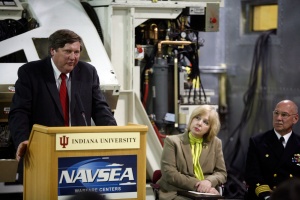Apr 15 2009
Indiana University and Crane Naval Surface Warfare Center recognized the success of an ongoing partnership to enhance national security and advance research opportunities in life sciences, physics and other fields during a ceremony Monday (April 13) at IU's Cyclotron Facility.
 IU physicist and LINAC principal investigator Paul Sokol, left, IU Provost Karen Hanson and Crane commander Captain Charles LaSota were among the speakers at Monday's ceremony.
IU physicist and LINAC principal investigator Paul Sokol, left, IU Provost Karen Hanson and Crane commander Captain Charles LaSota were among the speakers at Monday's ceremony.
IU physicist and LINAC principal investigator Paul Sokol, left, IU Provost Karen Hanson and Crane commander Captain Charles LaSota were among the speakers at Monday's ceremony.
IU has received $7.83 million in collaboration with Crane since 2007 to design improvements and upgrade equipment on a linear accelerator (LINAC) that will be used at the Cyclotron to test the effects of radiation on Department of Defense space and missile systems.
A linear accelerator in use more than 20 years at Crane no longer meets modern technological standards.
As the new Advanced LINAC Facility (ALF) supports the Defense Department's needs to ensure the survivability and reliability of space and missile systems in the radiation environment encountered in space, the project also will directly support a variety of IU research initiatives with access to a high brightness, fast pulsed X-ray source that can provide fluxes well in excess of those available in the most advanced university-based facilities.
"It's a win-win project and an unbelievably important partnership," said IU Provost Karen Hanson. "And it clearly satisfies IU's primary three-fold mission of providing opportunities for enhancing research, teaching and service."
IU researchers expect the facility to support development of innovations in the life sciences, including the rapidly expanding area of inquiry into nanobiological systems, and specifically, nano- and micro-fabrication to build devices for studying biosystems. The ability to organize matter in complex, communicative, non-equilibrium environments, across length scales from atoms to organisms, make biological systems the ultimate working example of nanotechnology.
The facility, which is expected to become fully operational in about two years, also will make important contributions to the study of energy related problems. The ALF will provide unique capabilities to study and possibly make critical contributions to new technologies addressing solar and biofuel energy generation, energy storage connected to nanotubes and hydrides, and energy systems like LED-based lighting designs.
A linear accelerator is an electrical device that accelerates subatomic particles. Most commonly used to deliver radiation treatments to cancer patients, the LINAC at the Cyclotron will deliver X-ray fluxes 10,000 times greater than those available in the most advanced university-based facilities and, in turn, will allow for dynamic life science research like protein folding to be studied.
"This is a prime example of the value that can be added by collaborations between the university and other agencies," said IU physicist Paul Sokol, principal investigator on the project. "Crane will end up with the access to a world class testing facility, and IU will have world class research facilities."
All U.S. Defense space and missile systems are required to survive radiation effects found in space, and prompt dose rate effects also arise from nuclear weapons. LINACs are a fundamental tool used to characterize the response of electronics in these types of environments, said Crane commander Captain Charles LaSota.
"These are high reliability systems that have to operate perfectly the first time and every time," he said. "And it's the men and women of Crane and here at IU that carry out this work that we rely on, and this tool will allow them to continue that work."
Federal support for the project began in 2007 with a $1.63 million appropriation, followed by $3 million in 2008 and $3.2 million in 2009. A congressional request for an appropriation of $1.17 million is currently pending for 2010.
U.S. Rep. Baron Hill said the project underscored Crane's importance as an economic shareholder in the region.
"Crane is the second largest employer in Southern Indiana so it's important we keep Crane here," he said. "We've had base closings all around the country, and we don't want that to happen to Crane."
Sokol said the next phase of work on the LINAC will be the installation in coming weeks of four 17-ton magnets that will form the core of the storage ring for the accelerator.